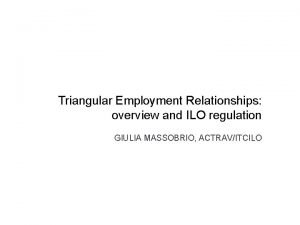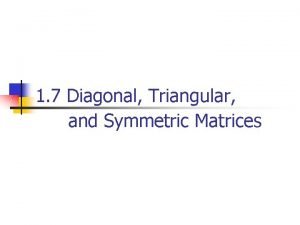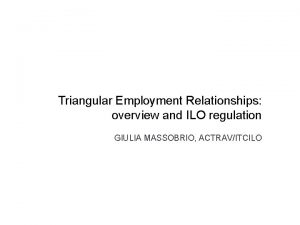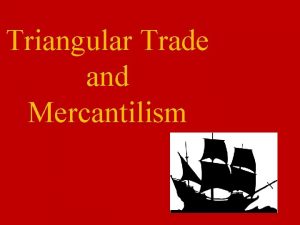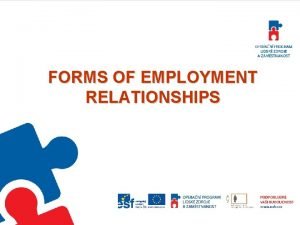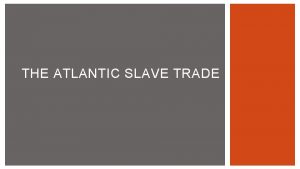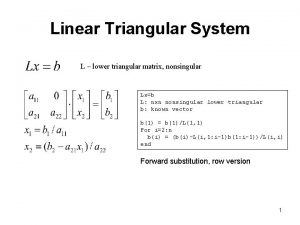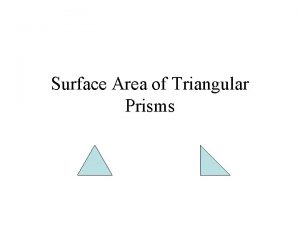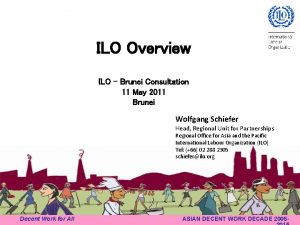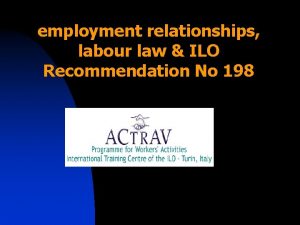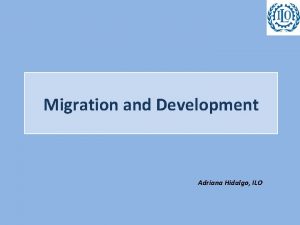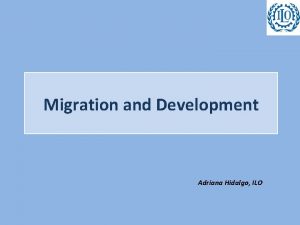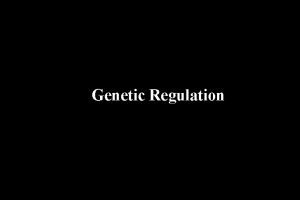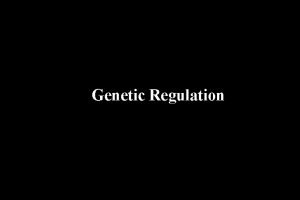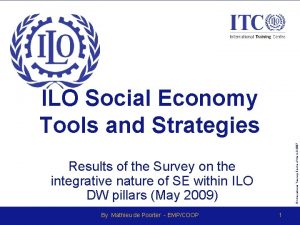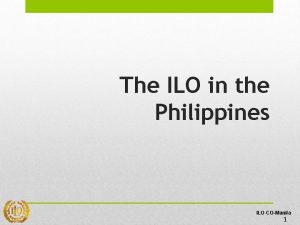Triangular Employment Relationships overview and ILO regulation GIULIA
























- Slides: 24

Triangular Employment Relationships: overview and ILO regulation GIULIA MASSOBRIO, ACTRAV/ITCILO

INDEX � 1. OUTSOURCING AND TRIANGULAR EMPLOYMENT RELATIONSHIPS � 2. HOW TRIANGULAR EMPLOYMENT RELATIONSHIPS AFFECT WORKERS � 3. ILO REGULATION OF TRIANGULAR EMPLOYMENT RELATIONSHIPS

1. OUTSOURCING AND TRIANGULAR EMPLOYMENT RELATIONSHIPS

What is “outsourcing”? OUTSOURCING: the practice of buying goods and services from outside suppliers, rather than producing or providing them within an enterprise.

…According to the Enterprise

“Triangular employment relationships” WORKER TRIANGULAR EMPLOYMENT RELATIONSHIPS: situation in which there is a III party (PROVIDER) between the EMPLOYMENT employee and employer, playing different RELATIONSHIP: relationship roles between a person called an EMPLOYEE �(the “worker”) and an EMPLOYER for whom the employee performs work under certain conditions in return for remuneration EMPLOYER EMPLOYMENT RELATIONSHIP

3 Types of triangular employment relationship SERVICES OF INTERMEDIATION “OUTSOURCING OF WORKFORCE” “OUTSOURCING OF SERVICES”

1) SERVICES OF INTERMEDIATION Functioning FEE-CHARGING EMPLOYMENT AGENCY/ PRIVATE EMPLOYMENT AGENCIES ENTERPRISE WORKER Intermediation EMPLOYMENT RELATIONSHIP

2) OUTSOURCING Functioning OF “WORFORCE” PRIVATE EMPLOYMENT AGENCY USER ENTERPRISE WORKER EMPLOYMENT RELATIONSHIP DIRECTION (who assigns tasks and supervises execution)

3) OUTSOURCING OF “SERVICES” Functioning ENTERPRISE USER ENTERPRISE WORKER EMPLOYMENT RELATIONSHIP DIRECTION (who assigns tasks and supervises execution)

2. HOW TRIANGULAR EMPLOYMENT RELATIONSHIPS AFFECT WORKERS ?

1) SERVICES OF INTERMEDIATION INDIVIDUAL LABOUR RIGHTS AT RISK COLLECTIVE LABOUR RIGHTS AT RISK Unclear working conditions Unfair advertising practices Misuse of personal data Abuses with migrant workers, included risk of trafficking and child labour

2/3) OUTSOURCING OF “WORKFORCE” and SERVICES INDIVIDUAL LABOUR RIGHTS AT RISK Employer’s responsibilities (i. e. social protection, OSH) on Agency instead of on user enterprise No participation to user enterprise’s utilities Wage inequality between Agency workers and user enterprise workers COLLECTIVE LABOUR RIGHTS AT RISK Prostration of affiliation to the user enterprise (case of user enterprise workers substituted with Agency workers) Agency workers cannot affiliate to user enterprise union Agency workers cannot exercise their right to strike against user enterprise User enterprise collective agreements don’t apply to Agency workers

3. ILO REGULATION OF TRIANGULAR EMPLOYMENT RELATIONSHIPS

ILO Standards on Triangular Employment relationships C. 34 (1933 ) C. 96 (1949 ) Revised by C. 181+ R. 188 (1997) R. 198 (2006)

Types of Employment Agencies PUBLIC EMPLOYMENT AGENCIES NON PROFIT PRIVATE FEECHARGING

ILO REGULATION OF “PRIVATE EMPLOYMENT AGENCIES” � AIM: while previous ILO C. 34 and 96 aimed to the “progressive abolition”of Pr. EA with an aim of profit, C. 181 recognises the “role which Pr. EA may play in a well-functioning labour market” C. 181 is aimed to regulate Private Employment Agency (Pr. EA) in order to “allow their operation as well as the protection of the workers using their services” C. 181 (1997)

Contents of Convention 181 (1) � STATE’S REGULATION OF Pr. EA: � System of licensing and certification clarifying the conditions governing their operation (art. 3) C. 181 RESPONSIBILITY FOR WORKERS’ RIGHTS PROTECTION: ART 12 �A Member shall determine and allocate the respective responsibilities of private employment agencies (in the case they are EMPLOYERS) and of user enterprises in relation to workers’ rights

Contents of Convention 181 (2) � RIGHTS recognized to Pr. EA WORKERS: � Freedom C. 181 of Association and Collective Bargaining (art, 4) � Right to equality of opportunity and treatment in access to employment (art. 5) � Protection of workers’ personal data (art. 6) � No directly or indirectly charge of any fees or costs to workers (art. 7) � Adequate protection of migrant workers (art. 8) � Abolition of Child labour (art. 9) � Adequate procedures for investigation of compleaints, abuses and fraudolent practices (art. 10)

ILO REGULATION OF “OUTSOURCING OF SERVICES” ? ? ? R: 198 (2006) RESULT OF THE ATTEMPT TO REGULATE OUTSOURCING OF SERVICES

Recomendación 198 (1) R: 198 (2006) � Antecedentes � Contenido básico y objetivos � Trabajo Decente � Indeterminación de la relación laboral: desprotección por inaplicación de la legislación laboral protectora � Política nacional de protección de los trabajadores en una relación de trabajo � Adaptación del ámbito de la legislación, con atención a las NIT � Medidas mínimas �Orientación a las partes �Acceso a mecanismos de solución de controversisas �Formación sobre NIT �Colectivos especialmente vulnerables

Recomendación 198 (2) � Determinación de la existencia de una relación de trabajo � Hechos de la ejecución de trabajo (Primacía de la realidad) � Presunción legal � Subordinación � Indicios específicos � Papel de la Negociación colectiva y el Diálogo Social � Importancia de la Recomendación � Reafirmación del principio protector � Aplicación jurisprudencial R: 198 (2006)


…Gracias!
 Triangular employment
Triangular employment Symmetric matrix multiplication
Symmetric matrix multiplication Giulia scaffidi
Giulia scaffidi Giulia gamba
Giulia gamba Giulia carboni
Giulia carboni Giochi per ripassare i verbi
Giochi per ripassare i verbi Immagini di friuli venezia giulia
Immagini di friuli venezia giulia Giulia bazzani
Giulia bazzani Clima friuli-venezia giulia scuola primaria
Clima friuli-venezia giulia scuola primaria Giulia bellemo
Giulia bellemo Analisi logica maestra giulia
Analisi logica maestra giulia Giulia di pietro
Giulia di pietro Montagna365 fvg
Montagna365 fvg Fereshte mozafari
Fereshte mozafari Laura fina
Laura fina Giulia visani
Giulia visani Giulia zanelli
Giulia zanelli Giulia olayemi
Giulia olayemi Generaroma
Generaroma Giulia
Giulia Size of the british empire
Size of the british empire Giulia raimondi oculista
Giulia raimondi oculista Giulia boselli
Giulia boselli Scherbenpark zusammenfassung
Scherbenpark zusammenfassung Giulia pancheri
Giulia pancheri
